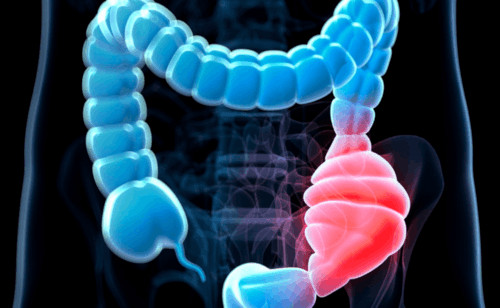Hirschsprung's disease
Developmental disorder of the nervous system of the intestine characterized by the absence of neurons responsible for producing intestinal movement.
What is Hirschprung's disease?
Hirschsprung's disease (HD) is a congenital disease, i.e. it is present from birth. It is a developmental disorder of the enteric (bowel) nervous system characterized by the absence of neurons responsible for producing intestinal peristalsis (movement). This absence of peristalsis causes an accumulation of gases and feces that cannot be expelled generating an intestinal obstruction.
Hirschsprung's disease (HD) is a congenital disease, i.e. it is present from birth. It is a developmental disorder of the enteric (bowel) nervous system characterized by the absence of neurons responsible for producing intestinal peristalsis (movement). This absence of peristalsis causes an accumulation of gases and feces that cannot be expelled generating an intestinal obstruction.
In most cases, approximately 80%, the lack of neurons affects only the rectum or rectosigmoid, the final part of the colon. However, in some cases, the segment without neurons may have a longer length of colon (long HD) and, in 5-10% of cases, it may affect the entire colon (total colonic HD) or even the entire small intestine (total intestinal HD).

Symptoms and Causes of Hirschsprung's Disease
Hirschsprung's disease (HD) affects approximately 1 in 5,000 live newborns. This disease has an important genetic component. It is considered a disease with complex inheritance and incomplete penetrance (not every carrier of the altered gene expresses the disease) and variable expressivity (different length of the affected segment of intestine).
In general, the long forms appear to have an autosomal dominant inheritance (50% risk of developing the disease) with incomplete penetrance, mainly due to RET gene alteration, whereas short segment Hirschsprung's disease appears to be transmitted in an autosomal recessive manner.
More than 20 mutations have been described in patients with Hirschsprung disease (HD) - mainly on chromosomes 2, 10 and 13 - that regulate neural crest development. Although most patients present in isolation, about 20% of patients with Hirschsprung disease (HD) may be associated with other pathologies including malrotation, genitourinary anomalies, heart disease, hearing loss, mental retardation, or other syndromes such as Down syndrome or Ondine syndrome, among others.
Hirschsprung's disease can present in three different forms, the first being the most frequent and characteristic of all:
- Intestinal obstruction in the newborn: The most frequent of all. Most infants with Hirschsprung's disease (HD) present with intestinal obstruction within a few hours of life, characterized by abdominal distension, bilious vomiting and absence of meconium elimination. In some patients intestinal perforation may be the initial symptom.
- HD-associated enterocolitis: Approximately 10% of children with Hirschsprung's disease may present with fever, abdominal distention and diarrhea at any age, outside of the characteristic neonatal period. This is due to a severe intestinal infection known as Hirschsprung's-associated enterocolitis. This infection of abdominal origin can cause sepsis (generalized infection). As HD is usually associated with constipation, the presence of diarrhea can be confusing. Careful history taking, including lack of meconium expulsion and the presence of intermittent obstructive episodes, should raise suspicion of the diagnosis.
- Chronic constipation in older children, adolescents or adults: Some patients with very short segment Hirschsprung's disease may have a late diagnosis during childhood or even in adulthood. Because constipation is common in childhood, it may be difficult for the primary care physician or pediatrician to differentiate HD from other more common causes of constipation. Clinical features that point to a diagnosis of Hirschsprung's disease include absence of meconium in the first 48 hours of life, failure to thrive, episode of diarrhea and abdominal distention, and no improvement with regular laxatives.
Diagnosis of Hirschsprung's Disease
Rectal biopsy: It is performed under sedation and consists of obtaining a biopsy of the rectum in order to identify the absence of neurons and compensatory hypertrophy of the nerve trunks. It can be performed in the neonatal period in newborns older than 36 weeks of gestation. It is the only definitive test that can confirm the diagnosis of the disease.

Barium enema: The barium enema is a radiological test performed without sedation that consists of introducing contrast material into the anus through a probe to identify the length of the aganglionic zone, which is observed to be narrower, and the transition zone with the healthy zone, which is observed to be more dilated.
Anorectal manometry: This test is performed without sedation and consists of introducing a small manometry probe through the anus in order to identify the inhibitory anal reflex, which is characteristically absent in HD patients. It is usually indicated in older patients with low suspicion; when suspicion is very high, a rectal biopsy is performed.
Treatment of Hirschsprung's Disease
The definitive treatment of Hirschsprung's disease (HD) is always surgical and consists of resection of the bowel without neurons and anastomosis (joining) of the healthy bowel to the anal canal, commonly called "descent surgery".
This procedure is performed between 3 and 6 months of age by laparoscopy with transanal anastomosis (union of the healthy intestine to the anal canal through the anus). This type of approach, being minimally invasive, allows a quick recovery, safer, less pain and better aesthetic result compared to the usual technique of pure transanal approach or combined with open surgery.
Up to the time of descent surgery, patients can be managed in two different ways:
- Rectal irrigations: Most patients with Hirschsprung's disease will have rectosigmoid involvement, so they can be managed with rectal irrigations with saline. These irrigations are essential for the child to be able to evacuate completely and avoid the risk of enterocolitis until the time of definitive surgery.
- Ileostomy: Patients with more extensive involvement or who do not respond to irrigations will need an ileostomy. It consists of a shunt from the bowel to the skin temporarily until descent.
In the older child with late diagnosis of Hirschsprung's disease (HD) with a very dilated colon secondary to chronic constipation, intervention should be delayed until the diameter of the colon decreases. This can be achieved byperforming daily enemas to prevent the accumulation of stool in the rectum-sigmoid. If the colon does not decompress sufficiently, a discharge ostomy may sometimes be necessary prior to descent or at the time of surgery.
Treatment outcome and prognosis
Functional problems may occur later, even if optimal surgical correction has been performed. These are summarized as obstructive symptoms/constipation or incontinence:

- Obstructive symptoms may present as abdominal distention, bloating, vomiting or constipation requiring continuous laxative treatment, enemas or irrigations. If these symptoms persist, enterocolitis associated with Hirschsprung's disease may develop.
- Postoperative incontinence may be due to sphincter damage during surgery (damage to the dentate line or internal anal sphincter) or to overflow pseudoincontinence secondary to chronic constipation with encopresis.
Although postoperative problems related to the disease itself or to the procedure frequently occur, most children with Hirschsprung's disease have a good long-term prognosis. In studies of adolescents and adults with HD, sexual function and quality of life are normal once they reach late adolescence.
Team of the Hirschsprung's Disease Unit


 +34 912 627 104
+34 912 627 104 Contact
Contact







